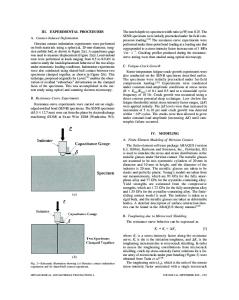The Effects of Annealing on Fatigue Behavior in Zr-based Bulk Metallic Glasses
- PDF / 516,311 Bytes
- 6 Pages / 612 x 792 pts (letter) Page_size
- 120 Downloads / 326 Views
The Effects of Annealing on Fatigue Behavior in Zr-based Bulk Metallic Glasses Peng Tong,1 Despina Louca,1 Yoshihiko Yokoyama,2 Anna Llobet,3 Gongyao Wang,4 Yunfeng Shi,5 Peter Liaw,4 Graham King,3 and Rick Spence6 1 Department of Physics, University of Virginia, Charlottesville, VA 22904, U.S.A. 2 Tohoku University, Sendai 980-8577, Japan. 3 Los Alamos National Laboratory, Los Alamos, NM 87545, U.S.A. 4 The University of Tennessee, Knoxville, TN 37831-6376, U.S.A. 5 Rensselaer Polytechnic Institute, Troy, NY 12180, U.S.A. 6 Argonne National Laboratory, Argonne, IL 60439, U.S.A. ABSTRACT The effects of annealing and fatigue on the local structure of Zr50Cu40Al10 and Zr60Cu30Al10 bulk metallic glasses (BMG) were investigated using the pair density function (PDF) analysis of synchrotron X-ray and neutron diffraction data. Our results indicate that the two compositions respond differently to annealing. The first PDF peak becomes sharper after annealing in Zr50Cu40Al10 with its intensity increasing, indicating that short-range ordering may be induced after the heat treatment. On the other hand, in Zr60Cu30Al10, the effects due to the heat treatment on the local structure are more subtle. Separately, the as-quenched and annealed alloys with the composition Zr50Cu40Al10 were subjected to fatigue loading conditions with ~ 106 compression cycles. The room temperature measurements showed changes in the local structure with fatigue especially for the annealed sample, involving the Cu-Zr correlations. Our results suggest that the physical properties of BMGs upon fatigue loading conditions may become accentuated due to the structural relaxation brought upon by annealing, leading to observable structural changes at the atomic level from fatigue. INTRODUCTION The emergence of BMG alloys with good glass-forming ability and slow cooling rates has given rise to a new class of structural materials that may be suitable in a wide range of engineering applications [1-5]. BMGs have superb physical properties, such as high corrosion and wear resistance, high yield strength, soft magnetic, and even superconducting properties [68]. Nowadays, BMGs can be made with cooling rates as low as 100 -102 K/s [9], while the metallic glasses were originally synthesized by rapidly quenching the liquid phase at rates of 106 K/s [10]. The low cooling rates enhance the possibilities of application since bulk sample with big sizes can be made easily. On the other hand, BMGs may undergo structural relaxation originating from a low cooling rate or annealing after vitrification [11]. The structural relaxation can lead to the degradation of mechanical properties [12,13]. Thus it is crucial to study how the structural relaxation affects the mechanical behavior by investigating the local structure. Knowledge of the short and medium range order in metallic glasses is important in order to understand the origin of local topological and chemical ordering. The PDF analysis via highenergy synchrotron X-ray and neutron diffraction provides a direct way to studying the
Data Loading...











